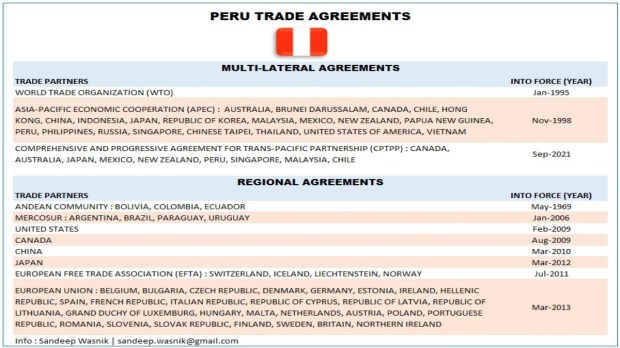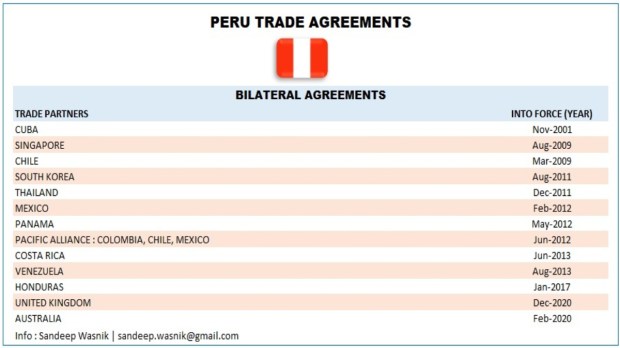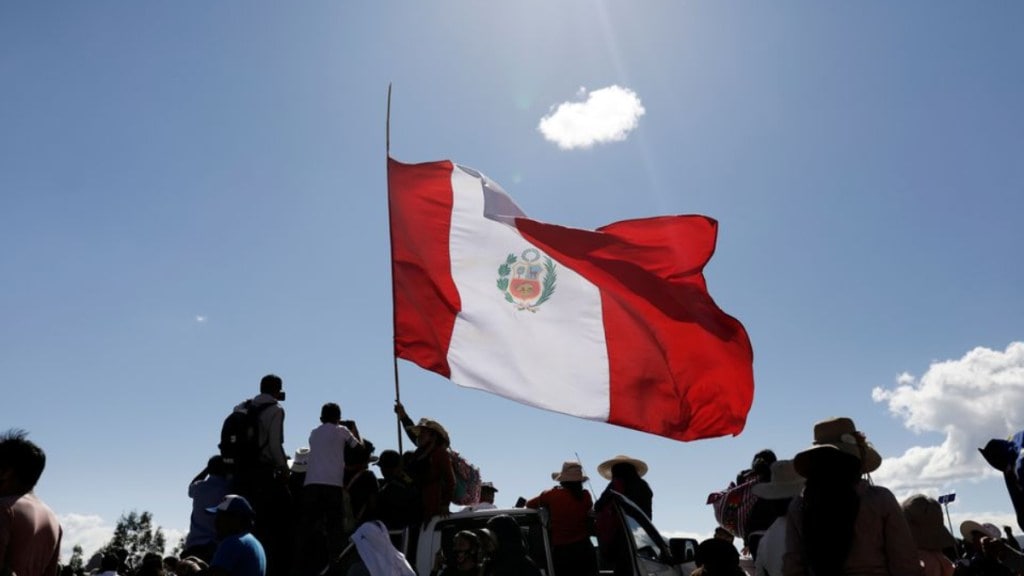By Sandeep Wasnik
India and Peru mark 60 years of diplomatic ties. The diplomatic relations were established on 26th March 1963, and the Indian embassy in Chile was jointly accredited to Peru. The two countries have both shifted their attention to one another’s regions since the late 1990s – “India to Latin America and Peru to Asia”. In November 1997, India’s Ministry of Commerce initiated a Trade Promotion Programme “Focus:LAC”, to strengthen trade links with the Latin America region’s for expanding
importance. Let us understand Peru’s economy and trade. Peru has a mixed economic system that combines various forms of individual freedom with centralized economic planning and governmental regulation. The World Bank has categorized the
Peruvian economy as upper middle income and describes it as an evolving social market economy that is heavily dependent on foreign trade. This significant Peru’s economy remains mainly dependent on exports, making it more vulnerable to fluctuations in global market pricing as well as global economic policies and decisions.
Peru: An export-driven economy
Peru’s economy is driven by the exploitation of the country’s abundant mineral resources, which are primarily reliant on exports. Over the last decade, exports accounted for roughly a quarter of Peruvian GDP, putting the economy vulnerable not just to global market turmoil and diminishing international demand for Peruvian resources, but also to commodity price variations. In 2021, about 30% of Peru’s GDP will be comprised by exports.
Peru is dominated by the market for exports, particularly those containing copper, zinc, and lead, precious metals like gold and silver, mineral oils and fuels, fruits and nuts, and animal feed (form of fish meal) are among the top exported items. The exported goods from Peru which are in top 5 are: Copper ores and concentrates are country’s major export, currently the country is the second-largest copper producer in the world and Peru’s top export product in 2022, valued $15.3 billion. The
second-largest export from the South American nation is gold, which is the fifth-largest producer of gold in the world. Gold exports from Peru in 2022 totalled $7.7 billion. Refined copper is the third- largest export and the value of refined copper exports in 2022 was $2.2 billion. Iron ore is the fifth-largest export item in 2022 totalling $1.78 billion.
Peru trade agreements
Since 1995, Peru has been a member of the World Trade Organization (WTO), and in 2016, it organised the APEC summit. In terms of trade openness, Peru placed 16th out of 141 nations in the 2019 according to the Global Competitiveness Index.
Additionally, On September 19th, 2021, Peru became a member of the Comprehensive and Progressive Agreement for Trans-Pacific Partnership (CPTPP) comprising Australia, Brunei Darussalam, Canada, Chile, Japan, Malaysia, Mexico, Peru, New Zealand, Singapore and Vietnam. The CPTPP is a high-standard FTA that seeks to encourage investment and trade among its participants. The CPTPP will aim to increase trade and investment in Peru and to aid in attracting the new investment. Furthermore, it has signed regional Free Trade Agreements (FTA) with the European Union, Andean Community, MERCOSUR, and European Free Trade Association (EFTA).
On March 1 2010, The Free Trade Agreement (FTA) between China and Peru came into force, and it eliminated tariffs on the majority of commodities exchanged between the two countries. Below table of Peru Trade Agreements.


India and Peru bilateral trade negotiations
Since June 2017, India and Peru have been discussing a Bilateral Trade Agreement (BTA). The BTA is intended to increase bilateral commerce and investment between the two countries, among others: tariffs, sanitary and phytosanitary measures, technical barriers to trade, investments, services, cooperation, and movement of people.
From August 8-11, 2017 in New Delhi, India hosted the first round of trade agreements talks with Peru. FromApril 9-12, 2018 in Lima, Peru hosted the second round of negotiations, where nine working groups met during this round to discuss topics such Market Access, Trade Defence, Services, and Investment. On December 7 2018 in New Delhi, the third round of discussions ended. The fourth round of trade talks between Peru and India was held in Lima, Peru, on March 11-15, 2019. On August 23, 2019, the fifth round of discussions ended in New Delhi, India. Due to the outbreak of the Covid-19 pandemic in 2020, the negotiations for a Trade Agreements were put on hold after a few rounds. Recently a government official announced that post September 2023 will start engaging in trade negotiations. If the countries are interested in FTAs, they will also look into possibilities and emphasise the determination to identify the most appropriate sectors for collaboration.
India and Peru bilateral trade
India’s exports to Peru are gradually increasing every financial year (FY : April–March). In FY 19 India exports to Peru were recorded at $721.16 million, followed by FY20 at $763.98 million, FY21 at $764.70 million, FY22 at $897.54 million, and FY23 at $865.79 million. Motorcycles, three-wheelers, cotton yarns and polyester, pharmaceuticals, iron and steel articles, plastic products, and automobile tyres are among India’s top exports to Peru. Below detailed Infographic shows India’s exports to Peru by month (five years data).

India’s imports from Peru according to the financial year (FY i.e., April–March). In FY 2018-19 India imports from Peru were recorded at US$2405.39 million, followed by FY 2019-2020 at US$1575.08 million, FY 2020-21 at US$1520.88 million, FY 2021-22 at US$2707.35 million, and FY 2022-23 at US$2250.72 million. Most of the imports from Peru include gold, copper, artificial fibers, calcium phosphates, fresh grapes, fish flour, and blueberries. Below detailed Infographic shows India’s imports from Peru by month (five years data).

Transit time and ocean freight: India-Peru
The distance between Jawaharlal Nehru Port Trust (JNPT), Mumbai Sea Port and Callao, Peru seaport is around 10631 nautical miles (approximately 19688.612 km), with a transit time ranging from 46 days (minimum) to 60 days (maximum), depending on shipping line. However, the transportation period from Callao, Peru to JNPT, Mumbai is 45 days (minimum) to 70 days (maximum), depending on shipping lines. This significantly means the buyer or importers need to wait for 2 to 3 months.

Since the past 5 months, the ocean freight has been gradually decreasing. The freight cost varies by shipping line; currently, the freight cost from JNPT, Mumbai to Callao, Peru is $1400 (minimum) to $1900 (maximum) for a 20ft dry container, and the freight cost from Callao, Peru to JNPT, Mumbai seaport is $3000 (minimum) to $5000 (maximum) for a 20ft dry container.
Importation Tariffs and other taxes in Peru
Peru has entered into nearly 21 trade agreements with 51 countries, this reduces the import duties (Ad/Valorem Duties) and benefits to importers. The landing cost is quite important from the buyer’s or importer’s perspective. It includes the price of goods, shipment costs, insurance fees, customs duties, overhead and any other charges incurred along the way (Product + shipping + insurance + customs + risk + overhead = landed cost). Trade agreements pave the way for products to enter the market at competitive prices, Trade agreements either make taxes exempt on imports or lower taxes. Let’s understand the tariffs and other taxes in Peru.
Ad/Valorem Duties are calculated on the basis of product cost, insurance, and freight. This is established by the World Trade Organization’s (WTO) Relative Agreement on Implementation of Article VII of the General Agreement on Tariffs and Trade (GATT) of 1994 (Valuation Agreement).
Depending on the tariff subcategory of the imported goods, the appropriate Ad Valorem charges are 0 percent, 6 percent, or 11 percent. More than 70 percent of the commodities listed in the tariff are exempt from duty. Imports of agricultural items such as rice, yellow corn, milk, and sugar are subject to additional variable duties. Fuel (gasoline), gasoil (diesel), liquor, cigars, tobacco, and some automobiles are all subject to the Selective Consumption Tax (SCT). Most of the imported goods are subject to Municipality Promotion Tax (MPT) and Value Added Tax (VAT). The MPT rate is 2%, while the VAT rate is 16%. The customs value of the imported goods additional Ad Valorem Duties additional SCT serve as the tax base for calculating both taxes.
Why is the trade agreement with Peru important for India?
The trade balance between India and Peru is in deficit for India. In FY 2022-23, India exported US$0.865 billion to Peru, while India imported US$2.25 billion from Peru. This means that India imported US$1.385 billion more from Peru than it exported to Peru. For more understanding India – Peru trade balance shown in Infographic by months, from April 2018 to March 2023.

There may be various reasons why India and Peru have a trade deficit. But there are a number of tariffs and other trade barriers that make it more expensive for Indian goods to be exported to Peru. Also, Peru holds several trade agreements with other countries, this makes barrier for Indian products enter Peru at competitive prices. Another reason may be that India is a major exporter of manufactured goods, while Peru is a major exporter of natural resources.
The Indian government is concerned about the trade deficit with Peru. In order to eliminate the economic obstacles between the two nations, the government is working to reduce the deficit by promoting exports to Peru and negotiating trade agreements to lower the imbalance.
The author is Latin American and the Caribbean Countries market Advisor and Consultant, also Director of International trade and Investment of Grupo 108.
Disclaimer: Views expressed are personal and do not reflect the official position or policy of the Financial Express Online.

